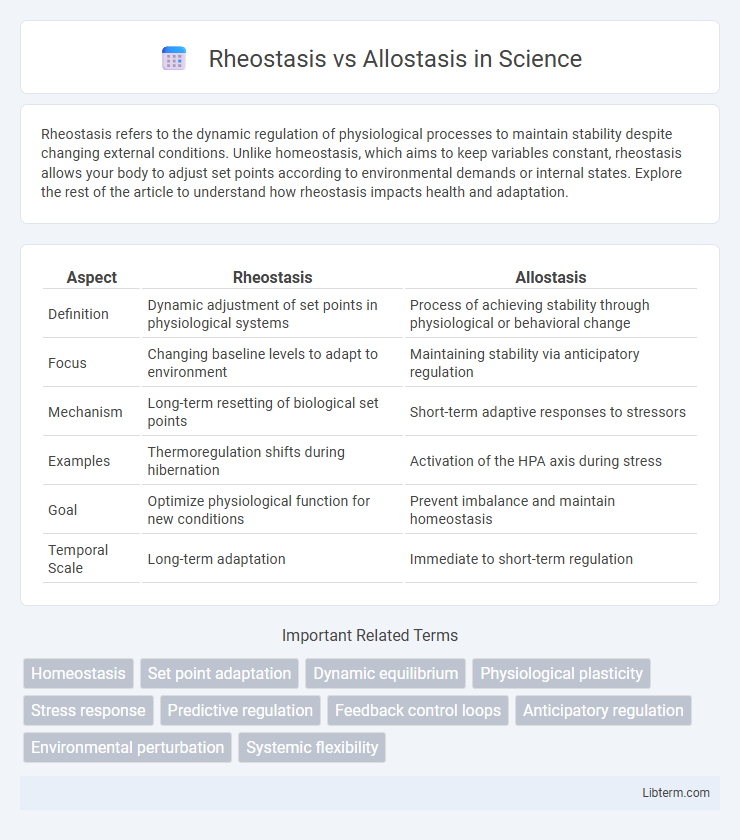Rheostasis refers to the dynamic regulation of physiological processes to maintain stability despite changing external conditions. Unlike homeostasis, which aims to keep variables constant, rheostasis allows your body to adjust set points according to environmental demands or internal states. Explore the rest of the article to understand how rheostasis impacts health and adaptation.
Table of Comparison
| Aspect | Rheostasis | Allostasis |
|---|---|---|
| Definition | Dynamic adjustment of set points in physiological systems | Process of achieving stability through physiological or behavioral change |
| Focus | Changing baseline levels to adapt to environment | Maintaining stability via anticipatory regulation |
| Mechanism | Long-term resetting of biological set points | Short-term adaptive responses to stressors |
| Examples | Thermoregulation shifts during hibernation | Activation of the HPA axis during stress |
| Goal | Optimize physiological function for new conditions | Prevent imbalance and maintain homeostasis |
| Temporal Scale | Long-term adaptation | Immediate to short-term regulation |
Introduction to Rheostasis and Allostasis
Rheostasis and allostasis are key concepts in physiological regulation, with rheostasis emphasizing the dynamic adjustment of setpoints in response to environmental challenges. Allostasis focuses on achieving stability through predictive physiological and behavioral changes to maintain homeostasis under stress. Understanding these mechanisms reveals how organisms adaptively manage internal balance beyond fixed targets.
Defining Rheostasis: Key Concepts
Rheostasis refers to the dynamic process by which biological systems adjust their set points to new stable levels in response to chronic environmental changes, differing from the fixed set points in homeostasis. This adaptive regulation involves modifying physiological parameters to maintain functionality under varying conditions, highlighting flexibility rather than rigid constancy. Key concepts of rheostasis emphasize the plasticity of internal states to accommodate long-term demands, ensuring survival and optimal performance in fluctuating environments.
Understanding Allostasis: Core Principles
Allostasis regulates physiological stability through dynamic adjustments in response to environmental and internal stressors, prioritizing predictive mechanisms over static balance. Unlike rheostasis, which emphasizes changing set points, allostasis involves adaptive processes that maintain homeostasis by altering multiple systems to anticipate future demands. Key principles include efficiency, flexibility, and integration of neural, endocrine, and immune responses for long-term health maintenance and stress resilience.
Historical Evolution of Homeostatic Theories
Rheostasis and allostasis represent evolutionary advancements in understanding physiological regulation beyond classical homeostasis, introduced in the early 20th century by Walter Cannon. While homeostasis emphasized maintaining static internal conditions, the concept of rheostasis, coined by Hans Selye, highlighted adaptive setpoints that shift in response to environmental demands. Allostasis, developed later by Peter Sterling and Joseph Eyer, integrated this dynamic regulation by focusing on achieving stability through change, emphasizing predictive and anticipatory physiological adjustments rather than fixed equilibrium.
Mechanistic Differences: Rheostasis vs Allostasis
Rheostasis maintains internal stability by adjusting set points in response to prolonged environmental changes, while allostasis achieves stability through active, predictive regulation of physiological parameters based on anticipated demands. Rheostasis involves modifying homeostatic set points to accommodate new conditions, whereas allostasis relies on dynamic, feedforward mechanisms that prepare the body before actual perturbations occur. Mechanistically, rheostasis represents a shift in the baseline of regulatory systems, and allostasis integrates multisystem interactions to optimize adaptation and energy efficiency.
Physiological Examples of Rheostasis
Rheostasis refers to the adaptive changes in physiological set points in response to chronic environmental or internal stimuli, unlike allostasis which emphasizes the process of achieving stability through change. Examples of rheostasis include fever, where the hypothalamic set point for body temperature is raised during infection to enhance immune function, and seasonal adaptation in animals like hibernating bears, which adjust metabolic rates and body temperature according to environmental demands. These physiological adjustments demonstrate how rheostasis involves long-term modulation of homeostatic parameters to optimize survival under varying conditions.
Adaptive Significance of Allostasis
Allostasis refers to the process by which the body achieves stability through physiological or behavioral change, enabling adaptive responses to environmental challenges. Unlike rheostasis, which involves fixed set-point adjustments in response to chronic changes, allostasis dynamically regulates multiple systems to maintain homeostasis in the face of stressors. The adaptive significance of allostasis lies in its ability to enhance survival and function by anticipating and efficiently managing variability in internal and external conditions.
Implications for Stress and Disease
Rheostasis maintains stability through dynamic set points adjusted to environmental demands, whereas allostasis involves active physiological changes to achieve stability. Chronic activation of allostatic mechanisms can lead to allostatic load, increasing vulnerability to stress-related diseases such as hypertension, diabetes, and depression. Understanding these processes highlights the importance of adaptive regulation in preventing stress-induced pathologies and informs targeted interventions for disease management.
Integrating Rheostasis and Allostasis in Research
Integrating rheostasis and allostasis in research enhances understanding of physiological regulation by distinguishing stable setpoint adjustments (rheostasis) from predictive, adaptive processes (allostasis). Investigations leveraging biomarkers such as cortisol and heart rate variability reveal how organisms dynamically balance internal stability with environmental demands. This synthesis offers a comprehensive framework for studying chronic stress, disease progression, and resilience mechanisms in translational health sciences.
Future Directions in Homeostatic Regulation
Future directions in homeostatic regulation research emphasize integrating rheostasis and allostasis concepts to better understand dynamic biological set points responding to environmental and internal stressors. Advanced computational models and wearable biosensors enable real-time monitoring of physiological fluctuations, facilitating personalized interventions that enhance adaptive capacity. Innovations in molecular and neuroendocrine pathway mapping promise targeted therapies optimizing homeostatic balance for chronic disease prevention and resilience building.
Rheostasis Infographic

 libterm.com
libterm.com